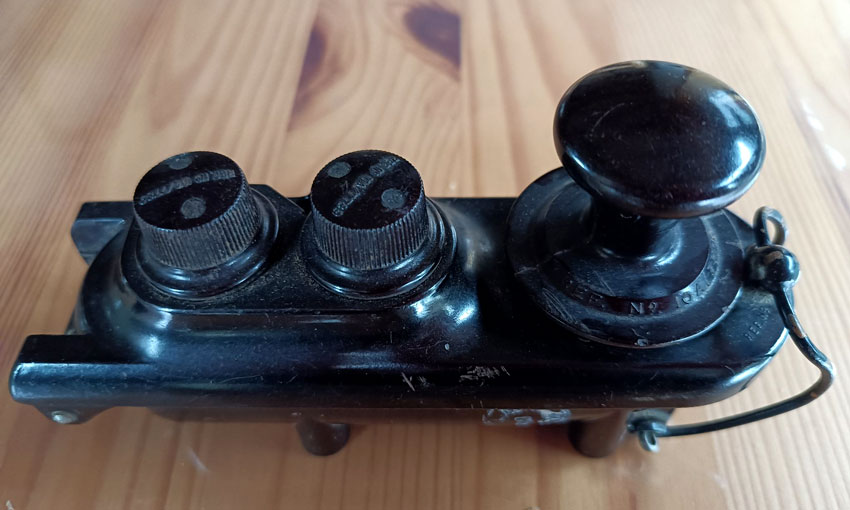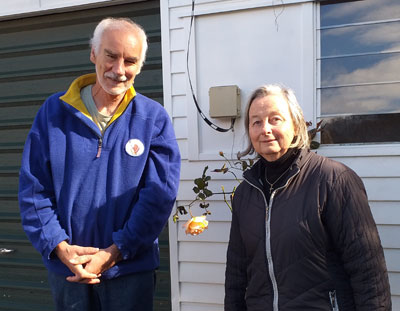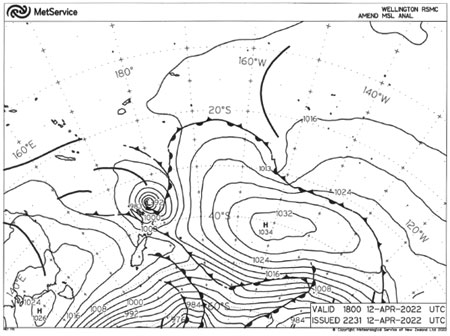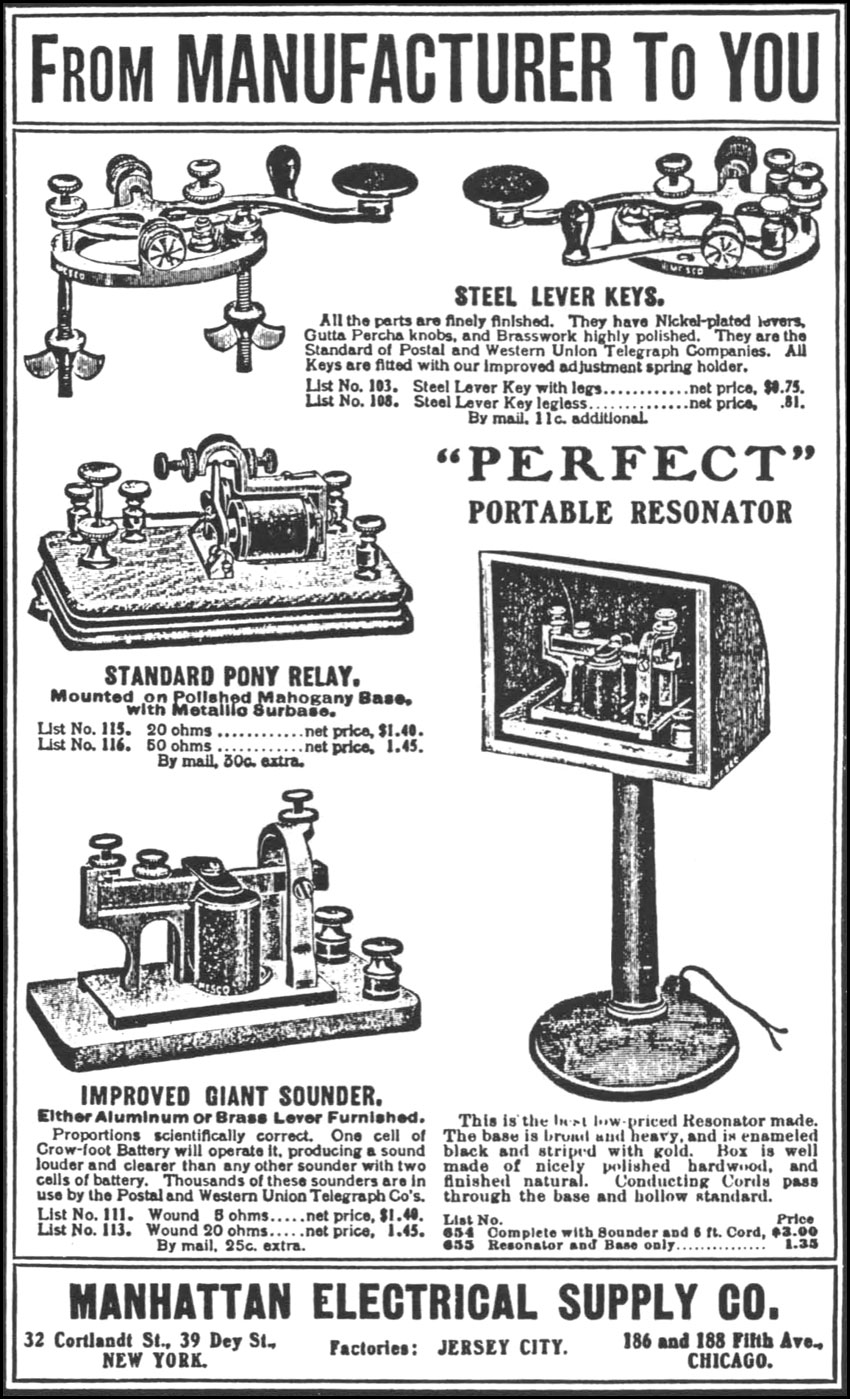This is a free fortnightly newsletter about the New Zealand Net.
If you would like to be notified by email when a new edition is published, please contact ZL1NZ.
Browse our Newsletter Archive and List of Net Tips.
Featured key

Photo: ZL2WT
By David ZL2WT
The RAF Type F morse key is a bakelite “flameproof” key that was widely used in British Commonwealth military aircraft during WW2. It is sometimes known as the Bathtub Key. Its enclosed design was to ensure that any arcing of the key contacts would not ignite fuel vapours in aircraft.
The Germans had a far superior flameproof key – which the Americans copied and made in great numbers.
It is not easy to send fast Morse code on a Bathtub Key and I would not recommend this key to anyone learning to send Morse.
Many were installed in aircraft to be used by the Wireless Operator / Air Gunner (WOP/AG) who would often be wearing thick gloves. The clip on the front of the key could be clipped over the lower edge of the knob for direction finding purposes or when the plane was ditching.
When I trained in telegraphy in the 1960s, these keys were common in Army Surplus stores. The best thing about them was the knob. Take the knob from a Bathtub key and fit it onto an army WT 8 Amp key and you then had a very good key for the higher speeds. It is interesting how many British keys in maritime and commercial installations used the knob that was originally designed for the Bathtub key.
I’ve seen reference to this model of key being installed in the following aircraft: Wellington, Swordfish, Anson, De Havilland Rapide, Hudson, Dakota, Lancaster, Wildebeest, Sunderland, Catalina and more.
* If you have an interesting key for this feature, please send me a nice clear photo and a few words describing it.
Quick notes
 Stephen ZL1ANY and his wife Georgina did a road trip north from Masterton in May, and dropped in for a visit with Bob ZL1AYN in Morrinsville and then with Neil ZL1NZ in Auckland. It was lovely to meet Stephen and Georgina (pictured here outside the ZL1NZ shack).
Stephen ZL1ANY and his wife Georgina did a road trip north from Masterton in May, and dropped in for a visit with Bob ZL1AYN in Morrinsville and then with Neil ZL1NZ in Auckland. It was lovely to meet Stephen and Georgina (pictured here outside the ZL1NZ shack).
Free Break-In magazines. Do you know someone who would like an instant library of Break-Ins? I have a large stack of them, dating from 1983 to 2022. Here’s the full list. I’d be happy to ship them too.
CW on 2m? A few days ago I added a 2m multi-mode rig to my station. The world above 30 MHz is quite new to me, so I would appreciate advice from any of our NZ readers who have experience operating CW on 144 MHz. I’ve put out a few CQs on 14.200 but no replies so far.
The rare Zedder paddles that were discovered at last year’s Dayton Hamvention and featured in NZ Net News 82, have found a home in the impressive key collection of NZ Net News reader Jan SM5LNE. This prompted me to create a census of Zedder paddles at the NZ Morse Key Directory, so if you know the whereabouts of any Zedders not already listed, please let me know.
The CW demonstration at MOTAT in Auckland on Sunday 18 June will use 7020 kHz, so please have a listen and join in if you can. Peter ZL1PX is organising this, and details are in NZ Net News 107.
Photo flashback

G2MI, Bromley, Kent in the 1962 RSGB Amateur Radio Handbook
Important changes to SKN
 I hope to hear you during New Zealand Straight Key Night (Winter Edition) which will be held this Sunday 11 June from 8pm to 9pm NZT (0800-0900 UTC) on 80 metres.
I hope to hear you during New Zealand Straight Key Night (Winter Edition) which will be held this Sunday 11 June from 8pm to 9pm NZT (0800-0900 UTC) on 80 metres.
There are a couple of changes for this edition, so please be sure to read this short note, and if you’re uncertain about anything, pop over to the SKN page for more info.
SKN honours the original amateur radio mode in an easy-going style. Operators send signal report, name, location, type of key, type of transmitter and power output. Stations are limited to 100W output power.
Change 1: Although SKN is not a contest, the operator who gets the most votes for the quality of their sending will win the Bruce Scahill Best Fist Award. This certificate honours Bruce ZL1BWG, a dedicated supporter of SKN, who died last December.
Please email me within one week after the event with your nomination for the ONE operator you feel is most deserving of this award.
Change 2: Due to popular demand, this SKN will see the return of the QSY Rule. Any station that calls CQ must QSY after making a contact. This will keep everyone on their toes!
SKN is open to all straight key operators, regardless of skill level or speed. I hope to work you on 11 June!
And please pass along this information to any other CW ops you know!
Weather maps the old-fashioned way
Gerard ZL2GVA sent me this email:
Just for fun I tried to recreate a weather map using the IAC Fleet Code example that you have on your website.
(Editor’s comment: The IAC Fleet Code consists of 5-character groups sent in Morse by a coast radio station to enable mariners to draw a weather map. It was very useful in the days before weather faxes. I copied this one as part of my daily routine while crossing the South Pacific in the late 1980s.)
Gerard continues: Here is the result. I suppose after all those years you might not recall seeing it!

Weather map of Southwest Pacific, hand drawn from IAC Fleet Code data by ZL2GVA
The isobars were pretty easy (after 99922), but I struggled a bit with the first lines. It was not easy to find a map with long/lat lines on it, in the end I found OpenSeaMap (it’s part of OpenStreetMap). But then the lat/long grid didn’t span over the 180° line from East to West, so I manually added those!
Nice job Gerard – and apologies for any errors in my copy that might have made the job challenging. When I look at my scribbling now, it seems pretty rough! We had a very small-scale chart of the entire South Pacific, folded to fit snugly into a large Ziploc bag (almost as big as the chart table). We could then draw on the plastic bag using dry-erase pens in different colours, and wipe it off when the next day’s code arrived. I actually thought these maps were nicer to use than the small monochrome ones I had seen printed on thermal paper from a weather fax receiver.

A weather radiofax. Image: MetService
On a related note…
New Zealand’s MetService has announced the closure of their long-running weather radiofax service effective 1 July 2023.
No, this does not mean a return to the joys of Fleet Code. 🙁
Rather, Metservice says radiofax has been made obsolete by the internet and satellites.
Hams mourn loss of Chip Margelli K7JA
As the ARRL said, in an announcement on 1 June: “The airwaves are markedly dimmer this week, social media is filled with heartfelt tributes, and industry leaders are mourning. A longtime fixture of amateur radio, Charles “Chip” Margelli K7JA, passed away after a brief illness.”
Most CW ops know one thing at least about Chip, namely that he was one of the two hams who appeared on a US television show in a contest to see which was faster: Morse Code or text messaging. Chip was the sending operator in that 2005 broadcast, and Ken K6CTW copied the message, securing the win for Team Morse Code. That famous video appears later in this edition of NZ Net News.
My thanks to Gordon West and ARRL for permission to republish the following tribute to Chip, a remarkable radio amateur.
_…_

Chip Margelli K7JA enjoying a day at the beach
Chip Margelli was a showman from his heart – never to brag, but loving the spotlight at ham conventions, or keeping the Visalia DX Convention laughing for over a solid minute on some fun antics from the podium. He had a wonderful voice!
He was always so positive about people and hamfests, with never a derogatory remark about anyone. At a ham fest which got the dates wrong, yet drew a “large” attendance of 50 folks, Chip would report it as an initial success in a new venue. Always positive!
Chip was a real DXer who could be eating an ice cream sandwich while sending CW at 50 wpm, all the while watching his smartphone for DX spots, and carrying on a conversation with a visiting ham.
On the Jay Leno TV show, he showed off ham radio CW to the world, easily beating out text messaging, with a classic blowing of his fingers in CW success as the fast(er) way to send messages. Chip’s wife Janet KL7MF managed the radios for the live-RF transmission during the show.
Chip could sense a band opening on 6 metres by the sound of the static crashes, and would instantly jump on 2 metres short skip when stations on 6 were coming in skywave at 100 miles. For Chip, it was “just the usual DX” to work SKYWAVE a dozen 2 metre SSB/CW contacts.
In Alaska, he knew exactly where to drive for seeing aurora long before it came in to view, and at the same time giving the A and K indices before we would see them on the screen.
When working phone, he would speak Japanese when the band was open to the West, Russian in an early morning 20 metre contact, and Spanish when working stations to the South – plus more languages I could never figure out. Chip knew the names by callsign of DX stations without a look-up.
He had fantastic knowledge of not only people, but nature. He could tell you the name of any bird tweet, the gender of bear tracks when we were in Alaska at their hamfests. He knew a dolphin from a porpoise, and could even sense when the tides would be changing.
During a few of our 10 GHz works at Field Day, he could tell me the attenuation of dry tall weeds vs poison oak!
We once got on the boat for some maritime DXing to a very rare ocean grid square, and never missed a contact with a pileup while we both were feeding the fish, so to speak, in very rough sea conditions. He never stopped smiling.
Chip and Janet were a team, and we so much appreciated their work with fellow volunteer examiners, especially putting our test takers at ease with a short ham radio story.
Chip loved music. He and Janet invited us to a holiday concert, where his booming baritone for the Hallelujah Chorus was heard by the entire concert hall, with applause! What an accomplished showman! From a tux to his favorite Hawaiian shirts, he was always best dressed for the occasion.
They loved animals, rescuing MC the cat from a Marie Calendar parking lot trash can. Then there was Sieku (CQ) a big Alaskan Husky, plus iguanas and even a pet possum.
Most everyone came to Chip for equipment, antennas, coax, band pass filters, advice. If ever you needed a KW trap for a 3-element Cushcraft beam, Chip had a side-yard collection of aluminium 6 feet high, and he knew every part in there. His love was building and home brewing beam antennas that we would take to the beach every Thanksgiving holiday. Every antenna was spot-on for minimum SWR.
He is a co-author to our VHF/UHF Propagation book, 2nd edition, with Ken Neubeck, with Chip adding a full chapter on how to work digital modes for long haul tropospheric ducting from LA to Hawaii, on 2 metres and above.
In March of this year, we began to plan for Field Day with the Orange County Amateur Radio Club, where Chip was just elected president. He did tell us he was getting some medical help on pains here and there, but he looked great, with that full head of wavy silver hair.
Chip was delighted to show us the Field Day plan for this year’s event – yes indeed, neatly piled and coiled low loss coax in his living room, and the in-line filters he expertly wound himself on the Palomar donut chokes. He was so pleased on the progress of planning and executing the work up of every piece of gear for the V/U station for Field Day.
He then settled in his big easy chair, with MC the cat and Janet right there beside him, gracefully closing his eyes, likely dreaming up more ham fun to come.
Chip, thank you for the memories, and lessons on being a real amateur radio operator, and a true friend to anyone who made contact.
Morse challenge
Nothing complicated this time. Just listen to this short question and send me your answer.
Please send your answers via radiogram to ZL1NZ, or via email if no propagation.
Answer to previous Morse challenge
The audio recording in NZ Net News 107 had Awarua Radio ZLB calling M/V Osuga LYFZ, a Soviet fishing vessel.
Correct answers were received from VK3DRQ, ZL1ANY, ZL1AYN and ZL2GVA.
Video
And here, just one more time, is the famous Morse Code versus Text Messaging contest from the Tonight Show.
Did you notice that Chip sneaked in a plug for “ham radio”? Great job!
Behind the scenes: There’s lots of interesting information about this broadcast in the ARRL Letter of 20 May 2005. Chip and Ken talked about the gear they used, the speed they chose (far below what they could have done) and the rehearsals for the show.
Advertising archive

1904
Suggestions?
If you have suggestions on how to make the NZ Net better, or things you’d like to see covered in these updates, please contact ZL1NZ. You might even like to write something for the newsletter.
Thanks for reading, and I hope to hear you soon on the NZ Net!
—
Neil Sanderson ZL1NZ, Net Manager
New Zealand Net (NZ NET)
3535.0 kHz at 9pm NZT Mon-Fri


